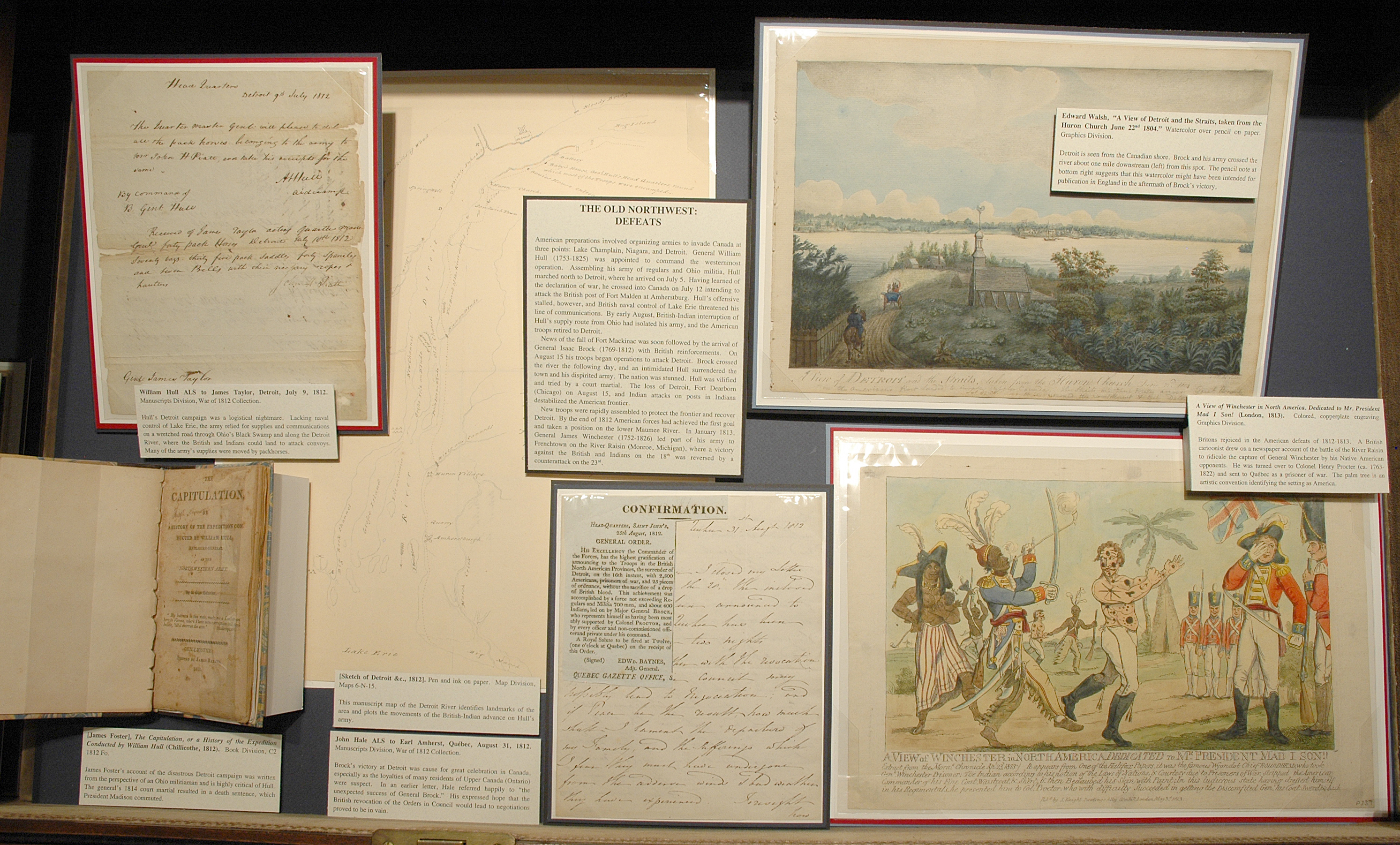The War of 1812: A Bicentennial Exhibition, Case 6
Case 6: The Old Northwest: Defeats
American preparations involved organizing armies to invade Canada at three points: Lake Champlain, Niagara, and Detroit. General William Hull (1753-1825) was appointed to command the westernmost operation. Assembling his army of regulars and Ohio militia, Hull marched north to Detroit, where he arrived on July 5. Having learned of the declaration of war, he crossed into Canada on July 12 intending to attack the British post of Fort Malden at Amherstburg. Hull’s offensive stalled, however, and British naval control of Lake Erie threatened his line of communications. By early August, British-Indian interruption of Hull’s supply route from Ohio had isolated his army, and the American troops retired to Detroit.
News of the fall of Fort Mackinac was soon followed by the arrival of General Isaac Brock (1769-1812) with British reinforcements. On August 15 his troops began operations to attack Detroit. Brock crossed the river the following day, and an intimidated Hull surrendered the town and his dispirited army. The nation was stunned. Hull was vilified and tried by a court martial. The loss of Detroit, Fort Dearborn (Chicago) on August 15, and Indian attacks on posts in Indiana destabilized the American frontier.
New troops were rapidly assembled to protect the frontier and recover Detroit. By the end of 1812 American forces had achieved the first goal and taken a position on the lower Maumee River. In January 1813, General James Winchester (1752-1826) led part of his army to Frenchtown on the River Raisin (Monroe, Michigan), where a victory against the British and Indians on the 18th was reversed by a counterattack on the 23rd.
Edward Walsh, “A View of Detroit and the Straits, taken from the Huron Church June 22nd 1804.” Watercolor over pencil on paper. Graphics Division.
Detroit is seen from the Canadian shore. Brock and his army crossed the river about one mile downstream (left) from this spot. The pencil note at bottom right suggests that this watercolor might have been intended for publication in England in the aftermath of Brock’s victory.
[Sketch of Detroit &c., 1812]. Pen and ink on paper. Map Division, Maps 6-N-15.
This manuscript map of the Detroit River identifies landmarks of the area and plots the movements of the British-Indian advance on Hull’s army.
[James Foster], The Capitulation, or a History of the Expedition Conducted by William Hull (Chillicothe, 1812). Book Division, C2 1812 Fo.
James Foster’s account of the disastrous Detroit campaign was written from the perspective of an Ohio militiaman and is highly critical of Hull. The general’s 1814 court martial resulted in a death sentence, which President Madison commuted.
John Hale ALS to Earl Amherst, Québec, August 31, 1812. Manuscripts Division, War of 1812 Collection.
Brock’s victory at Detroit was cause for great celebration in Canada, especially as the loyalties of many residents of Upper Canada (Ontario) were suspect. In an earlier letter, Hale referred happily to “the unexpected success of General Brock.” His expressed hope that the British revocation of the Orders in Council would lead to negotiations proved to be in vain.
William Hull ALS to James Taylor, Detroit, July 9, 1812.Manuscripts Division, War of 1812 Collection.
Hull’s Detroit campaign was a logistical nightmare. Lacking naval control of Lake Erie, the army relied for supplies and communications on a wretched road through Ohio’s Black Swamp and along the Detroit River, where the British and Indians could land to attack convoys. Many of the army’s supplies were moved by packhorses.
A View of Winchester in North America. Dedicated to Mr. President Mad I Son! (London, 1813). Colored, copperplate engraving. Graphics Division.
Britons rejoiced in the American defeats of 1812-1813. A British cartoonist drew on a newspaper account of the battle of the River Raisin to ridicule the capture of General Winchester by his Native American opponents. He was turned over to Colonel Henry Procter (ca. 1763-1822) and sent to Québec as a prisoner of war. The palm tree is an artistic convention identifying the setting as America.














